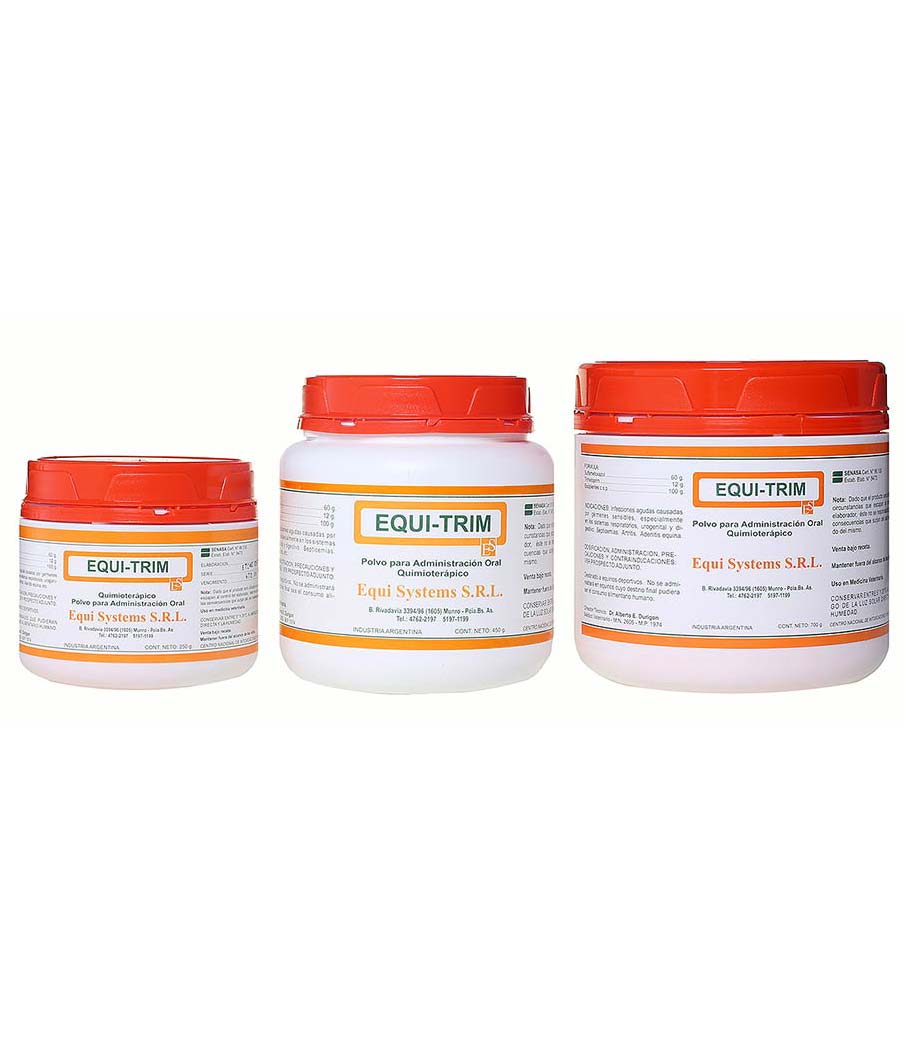Polvo para Administración Oral
Quimioterápico
FORMULA:
Sulfametoxazol 60g.
Trimetoprim 12g.
Excipientes c.s.p. 100g.
PRESENTACION: Potes de 250, 450 y 700 g.
DESTINADO A: Equinos deportivos
INDICACIONES:
A) Afecciones respiratorias agudas de origen bacteriano (neumonías, bronquitis, laringitis, pleuritis, etc)
B) Afecciones urogenitales (nefritis, pielonefritis, uretritis, cistitis, metritis, vaginitis).
C) Afecciones digestivas (enteritis, diarreas, peritonitis, infarto intestinal, colitis X, diarrea neonatal de los potrillos).
D) Otros: Actinobacilosis, artritis séptica, adenitis equina, onfalitis, osteomielitis, etc.
DOSIFICACION: La dosis para equinos adultos (considerado al Sulfametoxazol) es de 50 mg/kg p.v./día.
Para una dosificación práctica, calcular una medida al ras cada 200 kg. de peso vivo, cada 12 horas.
En caso de potrillos lactantes, donde el riñon no ha alcanzado la total funcionalidad, la dosis, referida al Sulfametoxazol, es de 30 mg/kg p.v./día, o sea el 1/3 de medida cada 100 kg de peso vivo, cada 12 horas.
La dosis de ataque (primera dosis) en equinos adultos (siempre referida al Sulfametoxazol) es de 100 mg/kg. y la de los potrillos lactantes 60 mg/kg.
ADMINISTRACION: Exclusivamente oral. El polvo puede mezclarse con la ración, pero es mejor, para evitar pérdidas, mezclarlo con agua o miel y administrarlo con una jeringa directamente en la boca. Una vez mezclado con cualquier vehículo, la mezcla debe administrarse inmediatamente.
CONTRAINDICACIONES Y LIMITACIONES DE USO: No administrar a equinos con afecciones renales (no bacterianas), hepáticas, ni a aquellos que tengan antecedentes de hipersensibilidad a alguno de los componentes del producto.
No debe combinarse con anestésicos locales, penicilina procaínica, Sulfato de D-anfetamina o maleato de clorfeniramina. Tampoco debe usarse en animales sospechosos de padecer discrasias sanguíneas.
No debe administrarse en ningún caso a animales de consumo.
PRECAUCIONES A ADOPTAR:
A) Que el paciente disponga de abundante agua de bebida.
B) Que el tratamiento sea instituido lo antes posible.
C) En tratamientos prolongados, controlar la fórmula sanguínea y la función renal.
D) Estar atentos a la posible aparición de síntomas de toxicidad. En caso de aparecer estos, suspender la medicación, alcalinizar la orina, y en caso necesario aplicar epinefrina.
E) En raras ocasiones el uso de estos antibacterianos puede determinar la aparición de diarrea aguda por alteración de la flora intestinal, que puede ser fatal.
Si durante el tratamiento se observan cambios en las consistencias de la materia fecal, éste debe discontinuarse y aplicarse medidas sintomáticas apropiadas.
CENTRO NACIONAL DE INTOXICACIONES: 0800-333-0160 - Mantener fuera del alcance de los niños- Venta bajo receta.
Uso en Medicina Veterinaria
Industria Argentina
Powder for Oral Administration
Chemotherapy drug
COMPOSITIUM:
Sulfamethoxazole 60 g
Trimethoprim 12 g
Excipients q.s. 100g.
PRESENTATION: Plastic containers with 250 g, 450 gand 700 g.
INDICATIONS:
A) Acute bacterial respiratory disorders (pneumonia, bronchitis, laryngitis, pleurisy, etc.)
B) Urogenital disorders (nephritis, pyelonephritis, urethritis, cystitis, metritis, vaginitis.)
C) Digestive disorders (enteritis, diarrheas, peritonitis, intestinal infarction, colitis X, neonatal diarrhea in foals.)
D) Other: Actinobacillosis, septic arthritis, equine adenitis, omphalitis, osteomyelitis, etc.
DOSAGE: The dose for adult horses (considering Sulfamethaxozole) is 50mg/kg live weight per day.For a practical dosage, calculate one level measure each 200 kg live weight every 12 hours.In cases of nursing foals, where the kidney has not got to its maximum functionality, the dose, regarding Sulfamethaxozole, is 30 mg./kg live weight/day, that is a 1/3 of the measure each 100 kg of live weight, every 12 hours.
The loading dose (first dose) in adult horses (always regarding Sulfamethaxozole) is 100 mg/kg, and for nursing foals, 60 mg/kg.
ADMINISTRATION: Oral administration only. The powder can be mixed with the food ration, but to avoid waste, it is better to mix it with water or honey and to administer it with a syringe directly in the mouth. Once mixed with any vehicle, the mix must be administered immediately.
CONTRAINDICATIONS AND RESTRICTIONS OF USE: Do not administer to horses with renal (non-bacterial) or liver conditions, or to those with history of hypersensitivity to any of the components of the product.
It must not be combined with local anesthetics, procaine penicillin, sulfate of D-amphetamine, or chlorpheniramine maleate. It should neither be used in animals that might suffer blood dyscrasia.
To be used in sport horses. Do not administer to horses that might be used for human food consumption.
PRECAUTIONS TO BE TAKEN:
A) The patient should have abundant drinkable water.
B) The treatment should start as soon as possible.
C) In long treatments, control the leukocyte formula and the renal function.
D) Pay attention to the possible appearance of toxicity symptoms. If they appear, interrupt the medication, alkalize the urine and, if necessary, apply epinephrine.
E) Very seldom, the use of these antibacterial drugs may determine the appearance of acute diarrhea caused by alteration of the intestinal flora, which may be fatal.
If during the treatment changes can be seen in the consistency of fecal matters, discontinue the treatment and apply appropriate symptomatic measures.
Keep out of the reach of children.
SENASA Certificate N° 96.150
For Use in Veterinary Medicine
Made in Argentina

